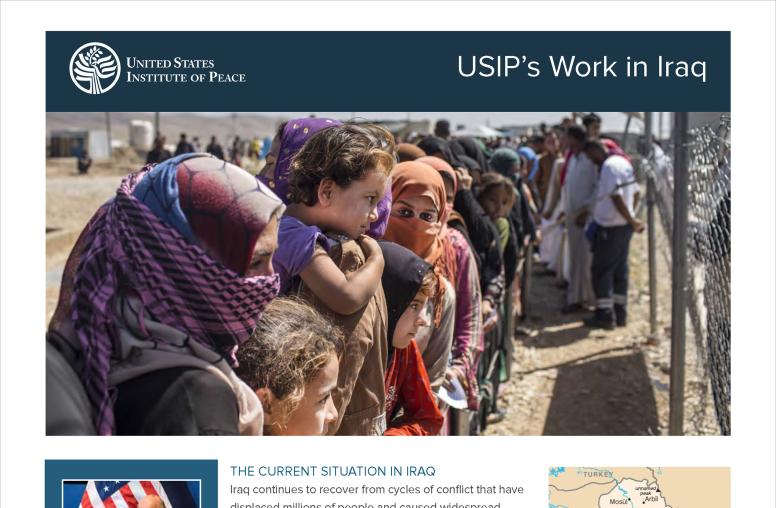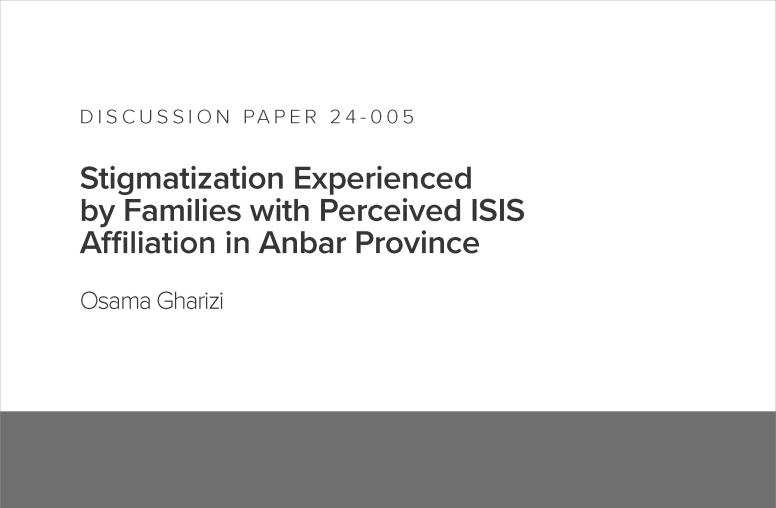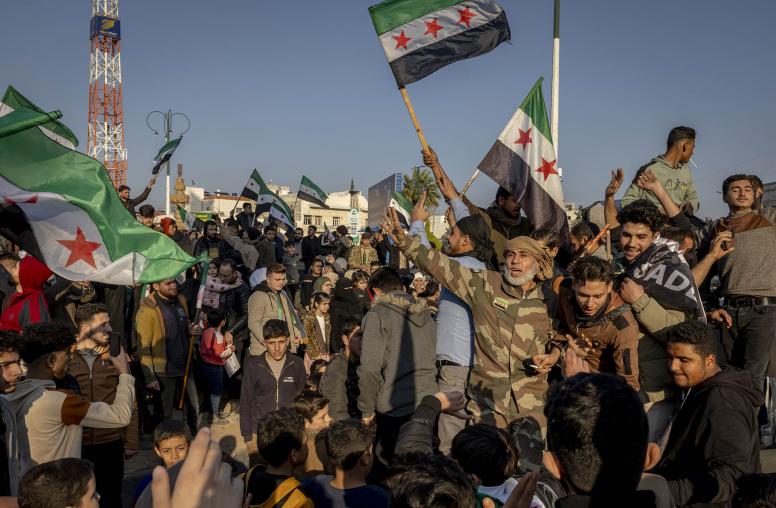Provincial Reconstruction Teams in Iraq
In January 2007, President Bush announced an expansion of the Provincial Reconstruction Team (PRT) program to help accelerate Iraq's transition to self-reliance. How can PRTs—intended to close the gap between civilian and military efforts—be evaluted effectively?
Getting civilian and military officials from the U.S. government to work together more effectively in conflict and post-conflict zones has been an enormous challenge in recent years. In both Afghanistan and Iraq, the United States has experimented with entities called "provincial reconstruction teams," (PRTs) which are intended to close the gap between civilian and military efforts as well as to enable civilians to work in insecure areas. This USIPeace Briefing examines the various models of PRTs that have been used and suggests the need for more rigorous ways of evaluating their effectiveness.
On January 10, 2007, President Bush announced an expansion of the PRT program to help accelerate Iraq's transition to self-reliance. As part of the president's "New Way Forward," the role of the new PRTs will be to bolster moderates, promote reconciliation, support counter-insurgency operations, foster development, and build capacity. New PRTs will work at the city, district, and neighborhood level. The goal will be to create areas where moderates will have political space to operate and where violent extremists are brought under control. The emphasis will be on shaping the political environment rather than on building infrastructure. Under the president's plan, the number of PRTs will double to 20. Six new PRTs will be embedded with Brigade Combat Teams (BCT) in Baghdad, three with BCTs in Anbar Province, and one with a BCT in Babil.
The PRTs will be established in stages. First, small teams composed of one representative each from State, Defense, USAID, and an Iraqi cultural adviser (provided by the Defense Department) will join the BCTs to conduct assessments and develop plans for future operations. These "joint management" teams will undergo pre-deployment training together, and will deploy in March 2007. In phase two, the advance teams will be joined by 140 specialists; a final phase will bring in an additional 142 staff. Of the "civilian" positions in the new PRTs, about 110 will be filled initially by military personnel called up from the National Guard and Army Reserve or recruited directly by the Department of Defense. The State Department will provide 19 foreign service officers, but will not be able to provide the other civilian personnel until Congress provides funding in this year's Iraq "Supplemental." At that point, State will recruit contractors with expertise in city management, business development, agribusiness, and other skills required. Total staff will increase by 322. State requested $538 million in funding from the Iraq Supplemental for the project. The new teams will be operational by June 1, 2007.
Under current plans, the BCT and PRT will be "one team, " which will receive guidance from both the U.S. ambassador in Baghdad and the commander of the Multi-National Force-Iraq. Within the PRT, the BCT commander will have the lead for issues related to security and movement. The PRT leader from the State Department will have the lead for political and economic issues. The mix of personnel will depend upon the skills needed in the brigade's area of operation. Recruitment will emphasize intangibles such as the ability to work in a challenging environment and to live and operate in "close quarters" in addition to such factors as expertise and availability.
The BCT will provide security, life support and operations for the PRT. In practice, civilian PRT members will be subject to Defense Department security regulations, which are less restrictive than those the State Department's Bureau of Diplomatic Security imposed on U.S. embassy personnel and on the original PRTs. This will make it easier for civilian PRT members to work "outside the wire" and to have increased contact with Iraqis. It will, however, involve additional risks, and there is the possibility of civilian casualties. Defense will pay for security and life support. Each embedded PRT will receive $20 million in project funds up to a total of $400 million. None of the new PRTs will involve Coalition partners.
Original Provincial Reconstruction Teams in Iraq Were Different
The new, embedded PRTs will differ significantly from the first ten PRTs established in Iraq. In designing these new teams, efforts have been made to overcome problems encountered in the start-up phase of the PRT program. According to their official mission statement, the original Provincial Reconstruction Teams were to "assist Iraq's provincial governments with developing a transparent and sustained capacity to govern, promoting increased security and rule of law, promoting political and economic development, and providing provincial administration necessary to meet the basic needs of the population."
Beyond "building sustainable capacity," a term which refers to the "transfer of skills and knowledge from Coalition Forces to the Iraqi people," there was no formal agreement among government agencies in Washington on what the PRTs were to accomplish. There was an initial 'instructions telegram' from Ambassador Khalilzad and Multinational Force Commander, General George Casey, establishing the PRTs, but there is no Washington interagency approved doctrine or concept of operations governing the first PRTs in Iraq. There is also no agreed set of specific objectives, delineation of authority and responsibility between civilian and military personnel plan, or set of job descriptions.
In November 2006, a memorandum of understanding was signed between State and Defense on the provision of security and the funding of infrastructure, life support, communications, and operating costs for the ten original PRTs. The agreement ended a prolonged interagency dispute between State and Defense that delayed the startup and hampered the operation of PRTs, particularly those located on U.S. military forward operating bases (FOBs). During the first year, problems went beyond the provision of security to the lack of basic logistic support. Shortfalls included such essential items as office space, office furniture, telephones, office machines and computers, and even pens and paper.
There were also problems with recruiting and training of civilian personnel. State had difficulty finding volunteers, particularly among essential mid-level officers with regional experience and relevant language skills. The State Department Foreign Service Institute will offer the first pre-deployment training program for PRT personnel in March 2007. At present there is no specific training program for prospective PRT personnel despite the fact that serving in a joint civilian-military unit under war-time conditions is a unique assignment for State Department and other civilian staff. There is an orientation course for all U.S. government employees going to Iraq.
In Iraq, the U.S. Embassy National Coordination Team (NCT), a part of the Iraq Reconstruction Management Office (IRMO), is responsible for PRTs. The NCT coordinates PRT activities and provides administrative support, including all functions relating to civilian personnel. The Multinational Force-Iraq (MNF-I) provides military personnel and supports PRTs operating from U.S. military bases. In practice, the first ten PRTs had considerable latitude in determining their own priorities and method of operation based upon local conditions, available resources, logistic support, and personalities. This allowed for flexibility, but it also required PRT leaders to improvise. Lack of established goals and information on completed projects made it difficult to determine whether PRTs were achieving "success," or whether better results would be obtained by using an alternative approach. Although it had the inter-agency lead, the State Department has not yet done an assessment to determine if PRTs are achieving their purpose.
PRTs do provide a secure platform for the U.S. civilian operations outside of Baghdad. Through courage and determination PRT personnel are providing assistance to Iraqis who would otherwise not be served. Those serving in PRTs believe they are making important contributions despite the frustration inherent in beginning a new enterprise.
PRTs were first established in Afghanistan
PRTs in Iraq were named after similar institutions operating in Afghanistan. The former U.S. ambassador to Iraq, Zalmay Khalilzad, was credited with bringing the idea for PRTs from his previous assignment in Kabul. In fact, there was little similarity between PRTs in Afghanistan and those in Iraq.
In Afghanistan, American PRTs--unlike those in Iraq--are commanded by an Army Lieutenant Colonel and composed entirely of military personnel with the exception of a single representative from the State Department, USAID, and the Department of Agriculture. Each PRT has two Army civil affairs teams of four soldiers each. One team was responsible for building small, quick impact development projects using local contractors; the other for the running the PRT's civil military operations center (CMOC) that coordinates activities with the UN and NGOs. Force protection is provided a U.S. Army National Guard platoon. PRTs have been established by the United States and then turned over to Coalition partners. All PRTs in Afghanistan are now subordinate to the NATO-led International Security Assistance Force (ISAF).
This USIPeace Briefing was written by Robert M. Perito, a senior program officer in the Center for Post-Conflict Peace and Stability Operations. It is based upon statements made by panelists at a USIP public event on PRTs in Iraq held on February 14, 2007, and on interviews with government agencies and commercial contractors that participate in the PRT program.
The United States Institute of Peace is an independent, nonpartisan institution established and funded by Congress. Its goals are to help prevent and resolve violent international conflicts, promote post-conflict stability and development, and increase conflict management capacity, tools, and intellectual capital worldwide. The Institute does this by empowering others with knowledge, skills, and resources, as well as by directly engaging in peacebuilding efforts around the globe.



